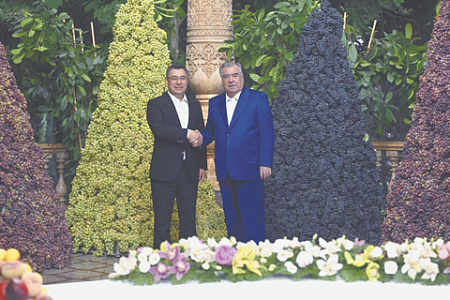Kyrgyzstan & Tajikistan Forge Economic Ties After Border Deal

A state visit by Kyrgyz President Sadyr Japarov to Tajikistan has marked a new chapter in the two nations’ relationship, pivoting from years of border disputes to a future focused on economic partnership. Following a historic border settlement, the talks with Tajik President Emomali Rahmon centered on revitalizing trade and cooperation, culminating in a package of agreements covering security, tourism, science, and ecology.
The foundation for this rapprochement was the landmark border agreement signed on March 13, 2025, which effectively ended decades of tension. President Japarov confirmed that the final demarcation of the border is expected to be completed shortly, noting a complete halt in border incidents since the process began. The signing of a new Agreement on Confidence-Building Measures further symbolizes the renewed trust between the neighboring countries.
Despite a 30% increase in bilateral trade to $6.1 million in the first five months of 2025, both leaders acknowledged that this figure remains critically low for two neighbors and agreed on measures to significantly boost it. The focus is on expanding mutual investment in agriculture, food, and light industry, with a joint national exhibition in Dushanbe showcasing the significant, yet largely untapped, potential of both economies.
In a key strategic move, President Japarov announced that Kyrgyzstan is prepared to serve as a vital transit corridor for Tajik goods to access the markets of the Eurasian Economic Union (EAEU). Speaking at an investment forum attended by over 500 entrepreneurs from both countries, Japarov positioned Kyrgyzstan as a gateway that could help Tajik products, such as its famous grapes, reach a wider consumer base under their own national brands.
This economic vision is underpinned by ambitious infrastructure projects. The leaders discussed increasing the number of direct flights and developing road networks. Notably, Tajikistan is now considering joining the transformative China-Kyrgyzstan-Uzbekistan railway project. This participation would not only expand the scale of the transport artery but also significantly amplify Tajikistan’s role in the regional economy.
Humanitarian cooperation was also a key theme, with both presidents participating in an online ceremony to reopen border checkpoints that had been closed during the conflict. They agreed to simplify border crossing procedures for citizens and pledged to support the ethnic and linguistic identities of the Kyrgyz minority in Tajikistan and the Tajik minority in Kyrgyzstan.
Experts have hailed the diplomatic breakthrough as a pivotal moment for the region. As political analyst Igor Shestakov noted, the agreement elevates not just bilateral economic ties but also trade within the entire EAEU framework, given Kyrgyzstan’s position on the union’s border in the Fergana Valley. Local officials, like Batken regional deputy Munarbek Baev, expressed hope for the swift return of cross-border trade, which is eagerly awaited by communities on both sides.
Alongside the economic agenda, the talks addressed pressing regional security challenges, including the fight against terrorism and extremism. This discussion comes as Tajikistan has reportedly begun a campaign to deport thousands of Afghan refugees. The move, which affects many former officials of the pre-2021 Afghan government, adds a complex layer to the regional security landscape and highlights the humanitarian concerns that continue to challenge Central Asia.